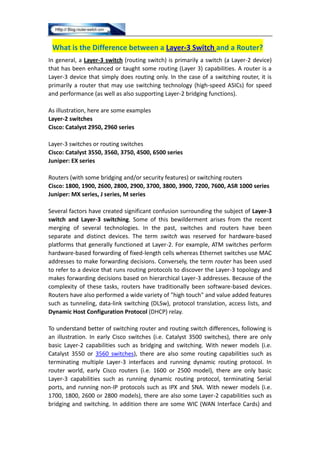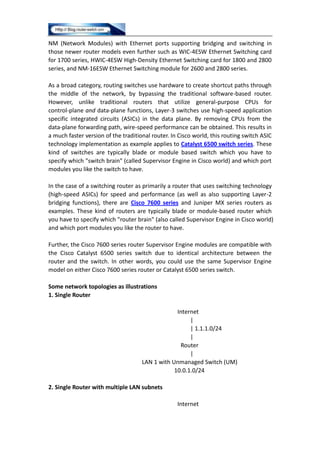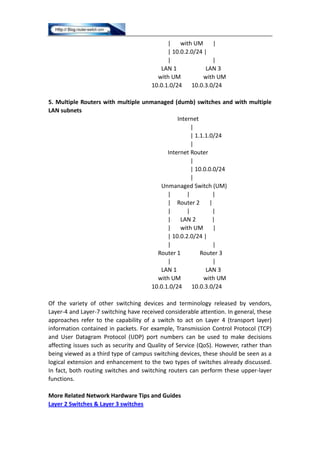Difference between a layer 3 switch and a router
- 1. What is the Difference between a Layer-3 Switch and a Router? In general, a Layer-3 switch (routing switch) is primarily a switch (a Layer-2 device) that has been enhanced or taught some routing (Layer 3) capabilities. A router is a Layer-3 device that simply does routing only. In the case of a switching router, it is primarily a router that may use switching technology (high-speed ASICs) for speed and performance (as well as also supporting Layer-2 bridging functions). As illustration, here are some examples Layer-2 switches Cisco: Catalyst 2950, 2960 series Layer-3 switches or routing switches Cisco: Catalyst 3550, 3560, 3750, 4500, 6500 series Juniper: EX series Routers (with some bridging and/or security features) or switching routers Cisco: 1800, 1900, 2600, 2800, 2900, 3700, 3800, 3900, 7200, 7600, ASR 1000 series Juniper: MX series, J series, M series Several factors have created significant confusion surrounding the subject of Layer-3 switch and Layer-3 switching. Some of this bewilderment arises from the recent merging of several technologies. In the past, switches and routers have been separate and distinct devices. The term switch was reserved for hardware-based platforms that generally functioned at Layer-2. For example, ATM switches perform hardware-based forwarding of fixed-length cells whereas Ethernet switches use MAC addresses to make forwarding decisions. Conversely, the term router has been used to refer to a device that runs routing protocols to discover the Layer-3 topology and makes forwarding decisions based on hierarchical Layer-3 addresses. Because of the complexity of these tasks, routers have traditionally been software-based devices. Routers have also performed a wide variety of "high touch" and value added features such as tunneling, data-link switching (DLSw), protocol translation, access lists, and Dynamic Host Configuration Protocol (DHCP) relay. To understand better of switching router and routing switch differences, following is an illustration. In early Cisco switches (i.e. Catalyst 3500 switches), there are only basic Layer-2 capabilities such as bridging and switching. With newer models (i.e. Catalyst 3550 or 3560 switches), there are also some routing capabilities such as terminating multiple Layer-3 interfaces and running dynamic routing protocol. In router world, early Cisco routers (i.e. 1600 or 2500 model), there are only basic Layer-3 capabilities such as running dynamic routing protocol, terminating Serial ports, and running non-IP protocols such as IPX and SNA. With newer models (i.e. 1700, 1800, 2600 or 2800 models), there are also some Layer-2 capabilities such as bridging and switching. In addition there are some WIC (WAN Interface Cards) and
- 2. NM (Network Modules) with Ethernet ports supporting bridging and switching in those newer router models even further such as WIC-4ESW Ethernet Switching card for 1700 series, HWIC-4ESW High-Density Ethernet Switching card for 1800 and 2800 series, and NM-16ESW Ethernet Switching module for 2600 and 2800 series. As a broad category, routing switches use hardware to create shortcut paths through the middle of the network, by bypassing the traditional software-based router. However, unlike traditional routers that utilize general-purpose CPUs for control-plane and data-plane functions, Layer-3 switches use high-speed application specific integrated circuits (ASICs) in the data plane. By removing CPUs from the data-plane forwarding path, wire-speed performance can be obtained. This results in a much faster version of the traditional router. In Cisco world, this routing switch ASIC technology implementation as example applies to Catalyst 6500 switch series. These kind of switches are typically blade or module based switch which you have to specify which "switch brain" (called Supervisor Engine in Cisco world) and which port modules you like the switch to have. In the case of a switching router as primarily a router that uses switching technology (high-speed ASICs) for speed and performance (as well as also supporting Layer-2 bridging functions), there are Cisco 7600 series and Juniper MX series routers as examples. These kind of routers are typically blade or module-based router which you have to specify which "router brain" (also called Supervisor Engine in Cisco world) and which port modules you like the router to have. Further, the Cisco 7600 series router Supervisor Engine modules are compatible with the Cisco Catalyst 6500 series switch due to identical architecture between the router and the switch. In other words, you could use the same Supervisor Engine model on either Cisco 7600 series router or Catalyst 6500 series switch. Some network topologies as illustrations 1. Single Router Internet | | 1.1.1.0/24 | Router | LAN 1 with Unmanaged Switch (UM) 10.0.1.0/24 2. Single Router with multiple LAN subnets Internet
- 3. | | 1.1.1.0/24 | Router --- LAN 2 with UM 10.0.2.0/24 | LAN 1 with UM 10.0.1.0/24 3. Single Router with single connection to a switch and with multiple LAN subnets (also known as "Router on A Stick" design) Internet | | 1.1.1.0/24 | Router * * Single Connection to a Switch using feature called Trunking * Layer-2 Managed Switch | | | | LAN 2 | | with UM | | 10.0.2.0/24 | | | LAN 1 LAN 3 with UM with UM 10.0.1.0/24 10.0.3.0/24 4. Single Router with Layer-3 Switch and with multiple LAN subnets Internet | | 1.1.1.0/24 | Internet Router | | 10.0.0.0/24 | Layer-3 Switch | | | | LAN 2 |
- 4. | with UM | | 10.0.2.0/24 | | | LAN 1 LAN 3 with UM with UM 10.0.1.0/24 10.0.3.0/24 5. Multiple Routers with multiple unmanaged (dumb) switches and with multiple LAN subnets Internet | | 1.1.1.0/24 | Internet Router | | 10.0.0.0/24 | Unmanaged Switch (UM) | | | | Router 2 | | | | | LAN 2 | | with UM | | 10.0.2.0/24 | | | Router 1 Router 3 | | LAN 1 LAN 3 with UM with UM 10.0.1.0/24 10.0.3.0/24 Of the variety of other switching devices and terminology released by vendors, Layer-4 and Layer-7 switching have received considerable attention. In general, these approaches refer to the capability of a switch to act on Layer 4 (transport layer) information contained in packets. For example, Transmission Control Protocol (TCP) and User Datagram Protocol (UDP) port numbers can be used to make decisions affecting issues such as security and Quality of Service (QoS). However, rather than being viewed as a third type of campus switching devices, these should be seen as a logical extension and enhancement to the two types of switches already discussed. In fact, both routing switches and switching routers can perform these upper-layer functions. More Related Network Hardware Tips and Guides Layer 2 Switches & Layer 3 switches
- 5. Cisco Catalyst 2960 LAN Base Series & Catalyst 2960 LAN Lite Series Main Network Hardware’s Difference: Integrated Devices, Router, Network Switch & Firewall Cisco ASA 8.4 vs. Typical NAT/PAT Configuration Cisco Catalyst 6500 vs. Cisco Nexus 7000 Switch What the Main Difference between HSRP, VRRP and GLBP Protocols How to Select Power Supply for Catalyst 3750-X Series and Cisco 3560-X Switch? Main Differences between Lines of Cisco 3750 Series Switches





